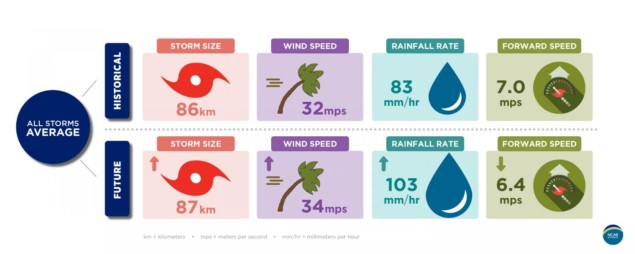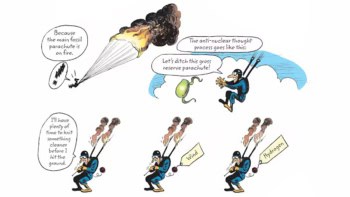
By the end of the century, hurricanes could be a lot wetter, as well as slightly stronger and slower moving. That’s according to an analysis of how 22 recent hurricanes would differ if temperatures had been 5°C warmer and the climate wetter.
“Our research suggests that future hurricanes could drop significantly more rain,” said Ethan Gutmann of the US National Center for Atmospheric Research (NCAR). “Hurricane Harvey demonstrated last year just how dangerous that can be.”
On average, the rainfall rate from the simulated future storms increased by 24%. As a group, these storms had 6% stronger average hourly maximum wind speeds and moved 9% slower. Their average radius remained the same.
Each storm had a unique pattern, however, with some becoming slightly weaker or moving slightly faster. None became drier.
“This study shows that the number of strong hurricanes, as a percent of total hurricanes each year, may increase,” said Ed Bensman of the National Science Foundation, which supported the study. “With increased development along coastlines, that has important implications for future storm damage.”
The 2017 hurricane season caused an estimated $215 billion in losses according to Munich RE. It was the most expensive on record.
There’s a trade-off when investigating hurricanes between resolution and computing resources. The climate models that run on a global scale over decades or centuries don’t have high enough resolution to pick out hurricanes but high-resolution weather models need a lot of computing power and aren’t generally run over the long-term.
Gutmann and colleagues used a new data set created at NCAR by running the Weather Research and Forecasting (WRF) model at 4-km resolution over the US for two 13-year periods –2001-2013 and a period with a climate about 5°C warmer, as could occur by the end of the century if greenhouse gas emissions continue unabated. The simulations took roughly a year.
The team found 22 named storms that had similar tracks in the historic and future simulations, making them easy to compare.
“Some past studies have also run WRF at a high resolution to study the impact of climate change on hurricanes, but those studies have tended to look at a single storm, like Sandy or Katrina,” Gutmann said. “What we find looking at more than 20 storms is that some change one way, while others change in a different way. There is so much variability that you can’t just study one storm and then extrapolate to all storms.”
It could be that fewer storms form in the future due to increasing atmospheric stability or greater high-level wind shear.
“It’s possible that in a future climate, large-scale atmospheric changes would make it so that some of these storms might never be able to form,” Gutmann said. “But from this study we get an idea of what we can expect from the storms that do form.”
The team published their results in Journal of Climate.


